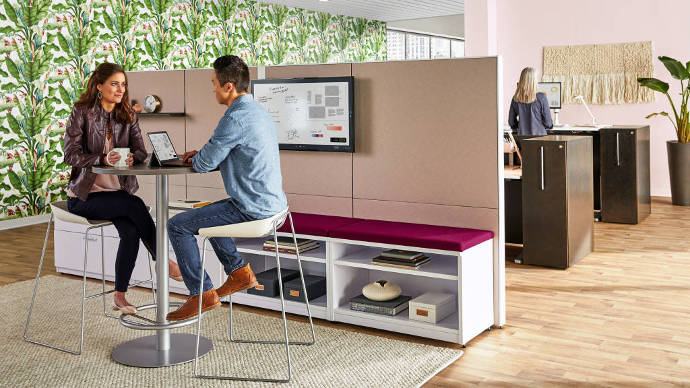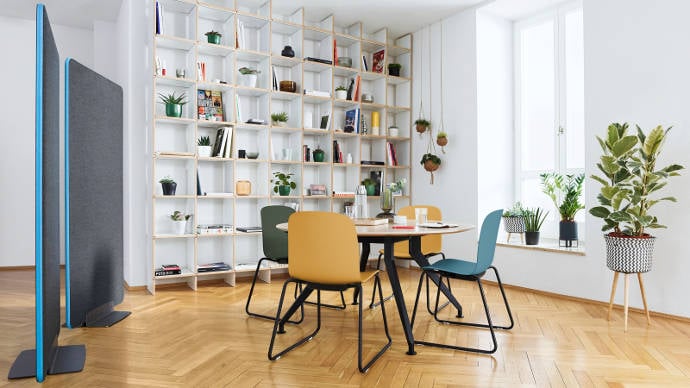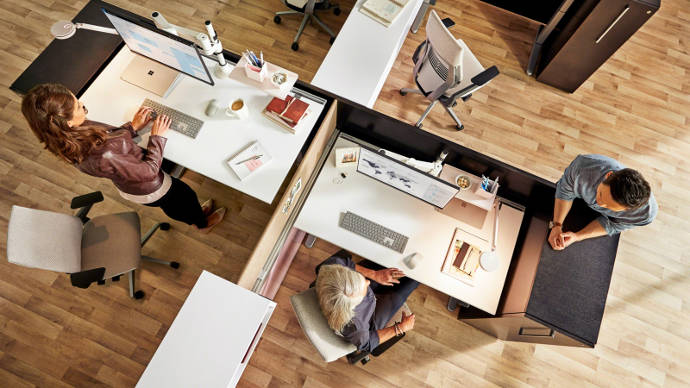We recently spoke to some of the architects and interior designers at the forefront of innovation in workplace design, about the trends they predict will become more important over the coming year and beyond.
What became clear in talking to our panel of experts is that the wellbeing of a diverse population of employees is now at the forefront of workplace design.
A look back at the last decade in workplace design
Over the last ten years, technology has transformed the way we work. As workers became more mobile, it grew evident that they didn’t need to be glued to their desks in order to be productive. People were able to work and connect with others from wherever they were. The pace of innovation and the rise of agile working also saw a shift to more hot-desking and open plan spaces that supported yet more collaboration. All this meant that business needs could be met more efficiently and effectively.
2.jpg?width=690&name=18-0110837%20(3)2.jpg)
A shift to more human-centred design
But the turn of the new decade has brought more emphasis on supporting the emotional, physical and mental wellbeing of employees at work. And it’s clear that until now, the holistic needs of the workers themselves have often been neglected.
High rates of employee anxiety and burnout have become an everyday reality and a real cost for business. Moreover, skills shortages and churn mean companies are having to work harder than ever to attract and retain top talent.
Against this backdrop, it’s perhaps no surprise that the theme that underpins almost all of our experts’ thoughts, is a focus on improving the workplace experience for employees. Because not only is wellbeing critical for employees’ personal fulfilment at work, but it’s vital to an organisation’s ability to thrive and innovate.
“In everything from furnishing, to workspace layout and the integration of technology, all our experts reflected that we are moving towards an era of ever more human-centred design.
An era where our workplaces can flex around us to support us in the shifting range of contemplative, collaborative and focused tasks that make up our working lives.
And a working environment that is more sensitive to our need for respite from cognitive and sensory overload.”

New challenges to face:
The demographic shift
As our experts noted, one of the biggest challenges emerging for businesses today is the huge demographic shift taking place within society. We are now seeing four and even five demographics working together, as the ageing population means people are working longer, and a new generation of young people enter the workforce. While a greater mix of experience and expectations promises more innovation and inspiration, it doesn’t come without conflict.
As Beatriz Gonzalez, Director at Scott Brownrigg, observed:
“There is a big generation piece happening. People are retiring later and later. By 2039 the age of retirement is expected to be 68, so you could have a 68-year-old working alongside a 24-year-old straight out of university.
We’re being asked more and more to design spaces not just for inclusivity, but specifically for spaces that address the spectrum of generations.
For example, the importance of light is huge for the older generation. The amount of time you can be in a meeting room with little natural light, focusing on a piece of paper, is going to be different as you get older and the workspace needs to cater for everyone.”

A neurodiverse workforce
Another big challenge observed by our experts is the need to support the full range of neurodiversity in the workplace. The noise and disruption that often comes with an open-plan office can be challenging for people who need quiet to do their best work. But for people with neurodivergent conditions like dyslexia and autism, it can be a great hindrance. The neurodiversity challenge further highlights the difficulty of creating spaces that work for all employees.
As Deepak Parmar, Design Director at MCM Architecture, explains:
“The biggest challenge is creating a space that works for everyone. What works for one user doesn’t always work for the next. People want to feel in control of their own space, so when I look at good workplace design, fundamentally, it offers choice and an element of adaptability for users.
It’s the same idea activity-based working was born from; having the ability to change the space to enable you to get your work done.”

Creating workspaces that bring out the best in people
These new challenges are underpinning an urgent shift to workspaces where everyone can thrive and feel valued, regardless of their age, neurological diversity, personality and learning styles. And all this has significant implications for the world of workplace design.
One of the biggest themes our experts observed is a trend towards giving workers a way of personalising the space to suit how they want to work. Furniture in these spaces is also becoming more adaptable; moveable furniture and accessories allow users to transform the space on demand.
Gale Moutrey, Global Vice President at Steelcase, noted:
“Giving teams the ability to control their own environment is also becoming a big deal.
We’ve had some interesting discussions about wheels, or casters, as the furniture world might call them. If you put a caster on something, you can move it around.
A wheel indicates that if a piece of furniture or technology doesn’t work for you in that space, then you can move it. These wheels symbolise your control and your ability to do anything you like.”
.jpg?width=690&name=19-0116891%20(2).jpg)
Other trends noted by our experts also support the wellbeing push; from contemplative no-tech zones to help workers relax and recharge, to design influences that reflect the local area, and experiential spaces inspired by the hospitality sector.
2020 certainly looks set to be a big year for pushing the wellbeing agenda and improving the employee experience in the workplace.
To discover what all our experts had to say about the trends shaping workplace design in 2020, download the free eBook:









